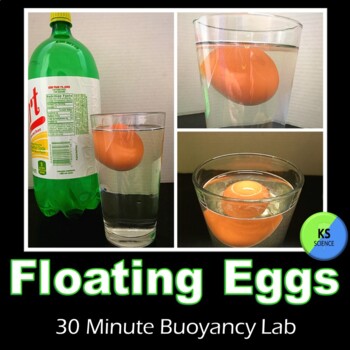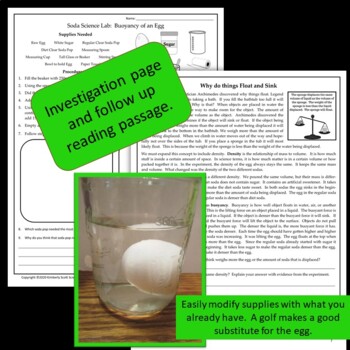Sink and Float Lab | A Floating Egg And Soda Experiment | Easter Science Fun
- PDF
- Easel Activity
Also included in
- Enjoy performing hands-on lab activities designed to be conducted in 30 minutes. Save time and money with simple supplies and low prep set-up. Included reading passages tie it all together after the lab. Bundle and Save and get all new additions at no extra cost. Each Lab IncludesBackground InPrice $30.80Original Price $38.50Save $7.70
Description
How are the densities of regular and diet soda pop different? This hands-on experiment will help students understand that density determines if an object will sink or float. This lab is an excellent introduction to the concept of buoyancy. It can be conducted in 30 minutes. Students will enjoy exploring with eggs and soda pop. A teacher guide and student reading passage are included.
Teachers will like the background information and tips for success. The supplies are simple and can be modified with what you have on hand. A golf ball can be used instead of an egg. The experiment can also be adjusted for multiple grade levels. Teachers like to use it during Easter and springtime.
A pre-created template for Easel by TPT is included. Just click "Open in Easel" on the product page. You can modify as needed. Please make sure you still download the PDF to see the complete teacher guide, tips for set-up, and TOU. This will allow you to perform as a demo with virtual students and they complete on their devices. Use caution if students are performing the lab with their device next to the supplies. You may find you prefer to print the papers, but this gives you flexibility.
Students will enjoy comparing the amount of sugar needed to float an egg. They will test two variables; regular and diet soda pop. Students will discover that regular soda is denser than diet soda. Using eggs helps give the students a better understanding of density and buoyant force. Students will also have lots of fun!
Appropriate for multiple grade levels. How deep you go into the science is up to you. All explanations are provided with vocabulary. For younger grades focus on if the egg sinks or floats and how much sugar was needed. For older grades expand into more detail about buoyancy and buoyant force. Students can expand on the terms and concepts. The reading passage is written more for the higher grade levels.
Included in the Hands-On Activity
- Background Information, Tips, and Vocabulary
- Hands-on Activity Page
- Summary Page/ Reading Passage
- Comparison Diagram for Class Discussion or Assessment
- Answer Keys
Supplies
Eggs or Golf Balls, White Sugar, Clear Soda Pop, Diet Clear Soda Pop, Measuring Spoons, Measuring Cup, Beaker or Tall Glass, Spoons, Bowl, Paper Towels
The 30 Minute Lab is part of a series. It evolved from being a science lab teacher. I see K-5 students once a week. I only get about 45 minutes with them. This allows me to introduce a topic in a fun, investigative way. It allows the students to have hands-on experience before the regular teacher teaches the concepts and terms. It also helps give the students an experience with the concept before introducing a STEM challenge on the topic.
Please follow my store so you can get notified as more are added. A bundle of all the labs is available. There is no extra cost to you as new labs are added to the bundle.
30 Minute Labs: Complete Bundle Pack
You may also like
Easter Science And STEM: The Floating Egg Density And Buoyancy Lab, GR 4/5
STEAM Activity: Experiment with Borax Crystal Growth with Grades 6/7/8
Water Drop Lab: Experiment With Surface Tension And The Properties Of Water
Remember leaving feedback earns you points toward FREE TPT purchases. I love hearing how the investigation went.
Also, follow us and be notified when new explorations are uploaded and deals.
Please contact us with any questions. We are here to help.
Yours in Science,
Kimberly Scott
Inspiring Lifelong Learnings through a Memorable Scientific Experience
All parts are copyrighted. Please see the terms of use in download. Please use good lab practices. The seller is not responsible for the use or misuse of the activities.







